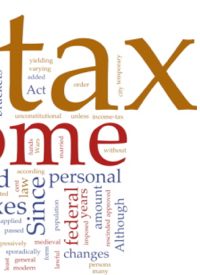
Each year the Tax Foundation, a nonpartisan tax research group based in Washington, D.C., calculates Tax Freedom Day by dividing the total of all federal, state, and local taxes collected that year by national income, then multiplying the result by 365. For 2012 the total tax burden — $2.62 trillion in federal taxes and $1.42 trillion in state and local taxes — comes to 29.2 percent of income; thus, Americans must work 107 days to pay all their taxes. Counting from January 1 and skipping Leap Day to keep things comparable from year to year, that means Tax Freedom Day falls on April 17.
According to the Tax Foundation, Americans will have to work 40 days to pay all their income taxes, 27 days for all social insurance taxes (e.g. Social Security, Medicare), 14 days for all sales and excise taxes, 12 days for state and local property taxes, 10 days for all corporate income taxes (because, the foundation notes, “all taxes on businesses are ultimately passed on to individuals”), and 7 days for all other taxes. In fact, government costs so much that “Americans will spend more in taxes in 2012 than they will on food, clothing, and housing combined,” the foundation observes.
This year’s Tax Freedom Day is four days later than last year’s and seven days later than when Barack Obama assumed the presidency. It would be an additional three days later this year had the payroll tax holiday not been extended through 2012. This is not the latest Tax Freedom Day has fallen, however; that honor goes to the year 2000, in which it fell on May 1.
Tax Freedom Day also varies from state to state. States with high taxes or high incomes (and therefore higher income tax collections) tend to have later Tax Freedom Days than other states. Tennesseans were the earliest to reach tax freedom this year, on March 31, while Connecticuters won’t be liberated from levies until May 5.
Sadly, the manner in which the Tax Foundation determines Tax Freedom Day understates the amount Americans pay toward government programs. For instance, the Tax Foundation uses a government calculation for Americans’ income that is based on the GDP though Census information shows that Americans’ median income is only weakly correlated with GDP, causing calculation error. Also, the Tax Foundation’s figures don’t take into account the “inflation tax” and other fees the government imposes on Americans directly and indirectly, as Kurt Williamsen explained in a 2009 article for TNA:
Governments often spend more than they collect in taxes through either creating money (inflation) or borrowing money (slightly delayed inflation). Inflation causes the price of goods to rise in an economy. In the United States, past government printing of money and increased energy costs (greatly caused by government regulations — a hidden tax) caused food prices to increase from $706.80 to $967.90 per month between August 2000 and August 2008 for a moderate spending family of four.
The ability to print money at will (inflation) insidiously allows for massive taxation and spending that doesn't come directly off people's checks, but it is a tax nonetheless.…
Worse, the U.S. tax burden … remains vastly underestimated because of the federal government's involvement in medical care. One out of every seven dollars spent in this country is related to medical care, and government-paid medical care — Medicare and Medicaid — pay to medical providers only a fraction of the actual cost of the care provided. Because the government accounts for over 45 percent of all U.S. healthcare expenditures, this dramatically drives up the costs in the private market because doctors and hospitals often make back their losses by increasing the charges to patients who have health insurance.
Wars and economic crises are always boons for government, and Tax Freedom Day’s trajectory over the years proves it. In 1917, it fell on January 24. Congress declared war on Germany 10 weeks later, and the next year Tax Freedom Day had advanced to February 8. By 1921, when Woodrow Wilson left office, it was February 22. “The Great Depression and the Hoover/Roosevelt tax increases led not only to a later Tax Freedom Day but a shift in who was collecting” from states and localities to Washington, the Tax Foundation reports. In 1943, U.S. involvement in World War II forced Tax Freedom Day to April for the first time, and “the federal tax burden never returned to pre-war levels,” the foundation remarks. The Vietnam War and 1970s stagflation pushed Tax Freedom Day all the way to April 24.
The only reason the current economic crisis has not advanced Tax Freedom Day very far is that the political climate in Washington has prohibited any major tax increases. Unfortunately, this has not caused the government to retrench spending. On the contrary, spending has continued to rise, leading to ever greater deficits, each of the last four topping $1 trillion. If the government were to tax Americans enough to cover all its expenses, Tax Freedom Day would not arrive until May 14 — almost a month later than it actually falls.
Tax Freedom Day can therefore be misleading. High tax collections because of economic growth can push it later in the year, while lower tax collections combined with massive deficit spending can cause it to arrive earlier. In theory, Tax Freedom Day could arrive January 1 if governments simply borrowed or (at the federal level) printed every dollar they spend; but this obviously would not be a good measure of the burden of government. Spending, not taxation, is the real yardstick for the size of government.
Of course, by any measure government at all levels is enormous. Back in 1900, when the federal government remained largely within the bounds of its constitutional powers and state and local governments were far more restrained, Tax Freedom Day arrived on January 22, and the federal government ran a surplus of $63 million. As Americans came to expect government to take care of them from cradle to grave, and as the federal government took on the role of world policeman, government grew inexorably, with the result that Americans must now work four-and-a-half months per year to pay for all government spending. With the retirement of the baby boomers and the inception of ObamaCare, the situation is only going to worsen.
If Tax Freedom Day is ever to recede significantly without piling on more debt for future generations, Americans will have to demand that their leaders abide by the Constitution and slash spending to what is necessary to perform government’s core function of protecting the population from criminals and invaders. The alternative is a nation in which Tax Freedom Day never arrives and, consequently, freedom itself is abolished.



